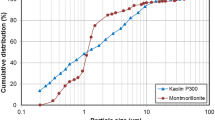Abstract
The tensile strength of clay is a major mechanical parameter and the main controlling parameter of tensile crack development which is generally encountered in geostructures. In this experimental study, 8-shaped direct tensile test and split tensile test were used to measure the tensile strength of compacted clay soil. Unconfined compression tests on the same clay samples were also carried out. Tensile strength and unconfined compression test results were compared. Laboratory tests were performed on Ankara clay and Kaolin clay with the addition of various proportions of synthetic polypropylene fiber, pulverized rubber, metal swarf, and bentonite. The data between the results of 8-shaped direct tensile tests, split tensile tests, and unconfined compression tests were correlated. This usage of different stabilizing agents enabled the authors to observe the reliability of the tensile strength measurement methods when soils’ mechanical properties were significantly changed and to develop universal equations which also can be applied to stabilized soils. The ratio of 8-shaped tensile strength to split tensile strength and to unconfined compressive strength was calculated to be 1.9 and 0.4, respectively. Also, the ratio of split tensile strength to unconfined compressive strength was calculated to be 0.2. Three equations were developed according to the Ankara clay and Kaolin clay mixtures’ tensile strengths, index properties, and compaction characteristics and proposed to estimate the tensile strength of fine-grained soils from their index properties.










Similar content being viewed by others
Abbreviations
- LL:
-
Liquid limit (%)
- PL:
-
Plastic limit (%)
- SL:
-
Shrinkage limit (%)
- PI:
-
Plasticity index (%)
- CC:
-
Clay content (%)
- \({\text{G}}_{\text{s}}\) :
-
Specific gravity
- \(\rho_{{d_{max} }}\) :
-
Maximum dry density (Mg/m3)
- w:
-
Water content (%)
- \({\text{w}}_{\text{opt}}\) :
-
Optimum water content (%)
- \({\text{q}}_{\text{u}}\) :
-
Unconfined compressive strength (kPa)
- \({\text{E}}_{\text{s}}\) :
-
Modulus of elasticity of soil (MPa)
- \({{\upsigma }}_{{{\text{t}}_{ 8} }}\) :
-
8-Shaped direct tensile strength (kPa)
- \({{\upsigma }}_{{{\text{t}}_{\text{split}} }}\) :
-
Split tensile strength (kPa)
- \({\text{T}}_{ \hbox{max} }\) :
-
Maximum tensile load (kN)
- P:
-
Compressive load on the cylinder (kN)
- D:
-
Diameter of the cylindrical specimen (m)
- L:
-
Length of the cylindrical specimen (m)
- A:
-
Cross-sectional area (m2)
References
Anggraini V, Asadi A, Huat BBK, Nahazanan H (2015) Effects of coir fibers on tensile and compressive strength of lime treated soft soil. Measurement 59:372–381. https://doi.org/10.1016/j.measurement.2014.09.059
Attom MF (2006) The use of shredded waste tires to improve the geotechnical engineering properties of sands. Environ Geol 49:497–503. https://doi.org/10.1007/s00254-005-0003-5
Barzegar AR, Oades JM, Rengasamy P, Murray RS (1995) Tensile strength of dry, remoulded soils as affected by properties of the clay fraction. Geoderma 65:93–108. https://doi.org/10.1016/0016-7061(94)00028-9
Blazejczak D, Horn R, Pytka J (1995) Soil tensile strength as affected by time, water content and bulk density. Int Agrophys 9:179–188
Brace WF (1964) Brittle fracture of rocks. In: Judd WR (ed) State of stress in Earth’s Crust. Elsevier, New York, pp 111–174
Divya PV, Viswanadham BVS, Gourc JP (2014) Evaluation of tensile strength-strain characteristics of fiber-reinforced soil through laboratory tests. J Mater Civ Eng 26:14–23. https://doi.org/10.1061/(ASCE)MT.1943-5533.0000772
Fang HW, Chen WF (1970) New method for determination of tensile strength of soils. Fritz Engineering Laboratory Report No. 348.5:62-68
Greene SBR, Egglenton AR, Rengasamy P (2002) Relationships between clay mineralogy and the hard setting properties of the soil in the Carnarvon Horticultural District of Western Australia. Appl Clay Sci 20(4–5):211–223. https://doi.org/10.1016/S0169-1317(01)00073-4
Karabash Z, Çabalar AF, Akbulut N (2015) The behavior of clayey soil reinforced with waste aluminium pieces. Procedia Earth Planet Sci 15:353–358. https://doi.org/10.1016/j.proeps.2015.08.088
Kim T-H, Kim T-H, Kang G-C, Ge L (2012) Factors ınfluencing crack-ınduced tensile strength of compacted soil. J Mater Civ Eng 24:315–320. https://doi.org/10.1061/(ASCE)MT.1943-5533.0000380
Li J, Tang C, Wang D, Pei X, Shi B (2014) Effect of discrete fibre reinforcement on soil tensile strength. J Rock Mech Geotech Eng 6:133–137. https://doi.org/10.1016/j.jrmge.2014.01.003
Perras MA, Diederichs MS (2014) A review of the tensile strength of rock: concepts and testing. Geotech Geol Eng 32:525–546. https://doi.org/10.1007/s10706-014-9732-0
Tang C-S, Pei X-J, Wang D-Y, Shi B, Li J (2015) Tensile strength of compacted clayey soil. J Geotech Geoenviron Eng 141:1–8. https://doi.org/10.1061/(ASCE)GT.1943-5606.0001267
Trabelsi H, Romero E, Jamei M (2018) Tensile strength during drying of remoulded and compacted clay: the role of fabric and water retention. Appl Clay Sci 162:57–68. https://doi.org/10.1016/j.clay.2018.05.032
Vaníček I (2013) The importance of tensile strength in geotechnical engineering. Acta Geotech Slov 10:5–17
Vesga LF, Vallejo LE (2006) Direct and indirect tensile tests for measuring the equivalent effective stress in a kaolinite clay. Unsatur Soils 147:1290–1301. https://doi.org/10.1061/40802(189)106
Win SS (2006) Tensile strength of compacted soils subjected to wetting and drying. Master’s Thesis, The University of South Wales, Sydney, Australia
Wood DM, Wroth CP (1978) The use of the cone penetrometer to determine the plastic limit of soils. Ground Eng 11:3–37
Zeh RM, Witt KJ (2007) The tensile strength of compacted clays as affected by suction and soil structure. Exp Unsatur Soil Mech 112:219–226. https://doi.org/10.1007/3-540-69873-6_21
Acknowledgements
The authors would like to express their thankfulness and a deep sense of gratitude to the Department of Civil Engineering, Middle East Technical University for providing the laboratories, facilities, and equipment to conduct and accomplish this study.
Author information
Authors and Affiliations
Corresponding author
Ethics declarations
Conflict of interest
The authors declare that there is no conflict of interest regarding the publication of this article.
Additional information
Publisher's Note
Springer Nature remains neutral with regard to jurisdictional claims in published maps and institutional affiliations.
Rights and permissions
About this article
Cite this article
Dagar, V., Cokca, E. A Study on Tensile Strength of Compacted Fine-Grained Soils. Geotech Geol Eng 39, 751–764 (2021). https://doi.org/10.1007/s10706-020-01519-8
Received:
Accepted:
Published:
Issue Date:
DOI: https://doi.org/10.1007/s10706-020-01519-8




